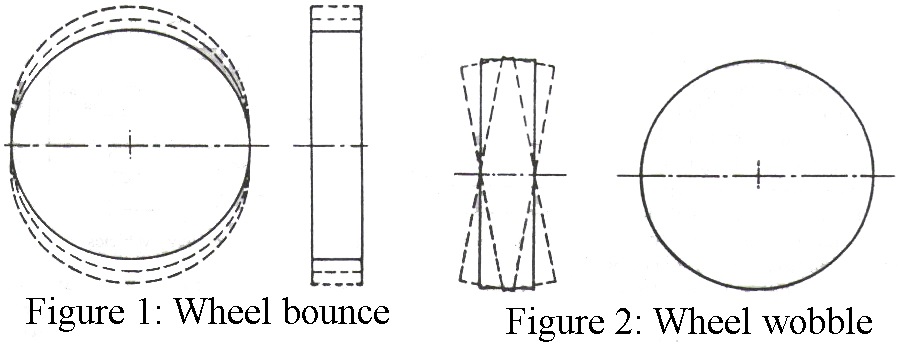In the article “Wheel and Tyre Troubleshooting” we will discuss the most common troubles occurring on account of wheels and tyres are discussed below, there are altogether thirteen points which we will have to know while troubleshooting wheel and tyre:
- Wheel bounce or Tramp (Figure 1)
The most obvious reason for this is the eccentricity of the wheel and tyre. If on checking, eccentricity is not found, the defect may be due to incorrect tyre pressure, statically unbalanced wheels or statically unbalanced brake drum. To determine which particular wheel is causing bounce, inflate all tyres to the higher pressure of 350 kPa and drive over the same roads. If now the bounce is eliminated, decrease the air pressure to the recommended value in one tyre at a time and repeat the road test. Repeat this procedure till all the tyres have been tested in this manner, i.e., one tyre at the recommended pressure and three tyres at the higher pressure. When the bounce again develops, the tyre at the recommended pressure is the defective one which must be replaced. This method of isolating the defective tyres is very effective in the case of cross-ply tyres but is not so effective in the case of radial tyres.
- Wheel wobble or Shimmy (Fig. 2)
This may be due to wearing out of the hub bearing of the wheel affected in which case it should be replaced. This defect may also be caused due to dynamic unbalance, which itself may be due to several reasons such as the buckled wheel, incorrectly fitted tyre, bent axle shaft etc.
- Side wear of tyres
When the tyre tread wears more at the sides than at the centre, it is due to low tyre pressure.
- One-side wear of tyres
This may be due to incorrect camber angle or incorrect toe-in or sagging axle on account of overloading. Continuous running on highly cambered roads may also result in this type of wear.
- Centre wear of tyre tread
The reason for this is the high tyre pressure.
- Uneven tyre wear
This is due to buckled wheel or the tyre and wheel assembly being out of balance. Sudden acceleration and braking also result in this type of wear.
- Uniform rapid wear
Driving on rough roads or fast driving are the causes of the uniform but rapid wear. It is estimated that the wear of tyres is at a speed of 80 kph. is approximately twice that at a speed of 50 kph.
- Rapid wear with feathered edges on the tread
This type of wear may be detected by placing fingers on the tread and moving slowly in the cross direction, first on one side and then on the other. This means the tyre has also been skidding. This may be due to incorrect wheel alignment. On the rear axle, this may be due to misalignment of chassis and displacement of the axle.
- Tread cracking
This is due to overloading, over-inflation or underinflation
- Tread or ply separation
This may be caused by overloading, excessive or insufficient air pressure, high speeds or impact. Small tread cuts when neglected may also lead to this trouble.
- Loss of pressure
Small loss of pressure takes regularly not due to any defect, but as an account of normal diffusion of oxygen through the tube material. However, the pressure loss of more than 5 pounds (35 kPa) in a week may be due to a faulty valve, leaking patch or even some puncture.
- Radial Tyre lead
Lead is the tendency of the car to deviate from a straight path even when there is no pressure on the steering wheel. Lead is caused by incorrect alignment, uneven braking adjustment or any defect in the tyre construction, e.g.,
- an off-centre belt in a radial tyre creates a side force on the vehicle resulting in the lead.
- if one side of a tyre has a larger diameter than the other, the tyre will tend to roll to one side, thereby developing a side force that may produce lead.
Front tyres with unequal treadwear may also cause lead. Rear tyres, however, do not cause lead.
- Radial tyre waddle
Waddle is side to side movement at the front and/or rear of the car, particularly noticeable at low speeds 10 to 50 km/hr. It is caused by the steel belt not being straight within the tyre. Waddle can be quickly diagnosed by using Tyre Problem Detector (TPD) and following equipment manufacture’s recommendations.
Check out other automobile troubleshooting tutorials posted on bestengineeringprojects.com
- Gearbox Troubleshooting
- Automobile Clutch Troubleshooting
- Automobile Suspension System Troubleshooting
- Precaution Regarding Automobile Tyres
- Automobile Lighting System Troubleshooting
- Brake Troubleshooting
- Automobile Steering Troubleshooting
